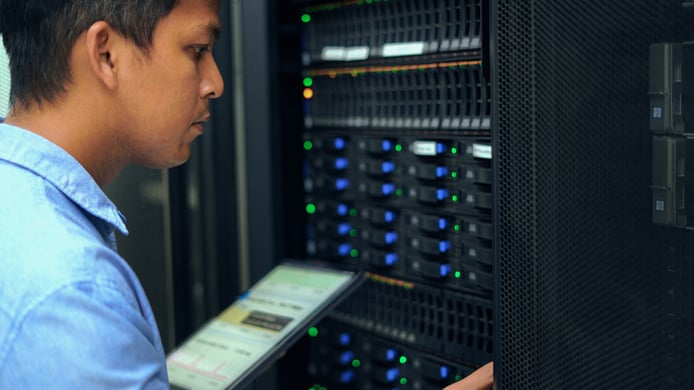Financial PCBs 101: PCB Design For Trading Platforms
Driven largely by technological advancements and the increasing demand for efficient trading solutions, the financial technology landscape is...
4 min read
 Matric Group
:
Feb 29, 2024
Matric Group
:
Feb 29, 2024

Data centers are crucial for the financial industry due to their pivotal role in ensuring speed, reliability, and security, which are fundamental for the operations of banks, investment firms, insurance companies, and other financial institutions.
When it comes to the role data center PCBs play in the continuous operation of the facility, reliability and security are only two of the most important factors. The financial industry, particularly in today’s world, requires speed to complete transactions and provide satisfactory service to those expecting it.
Below, we dive a little deeper into each of the three attributes:
PCBs within data center components are intricately designed to support the high-speed, reliable, and secure operations that are critical to the financial industry and other sectors reliant on data center services.
Their role encompasses everything from processing and connectivity to heat management and environmental monitoring, highlighting the importance of advanced PCB design and technology in the efficient operation of data centers.
Data center PCBs are designed in multiple layers that:
These PCBs handle high-speed transmission and maintain optimal performance in an environment that requires high levels of electricity, which needs to be maintained to provide sufficient levels to all components while minimizing energy consumption.
PCBs have specific functions and roles within various components that are vital, enabling the high-speed processing, connectivity, and data storage capabilities that data centers require, including within:
PCBs in servers host the central processing units (CPUs), memory modules (RAM), and other processing elements. These components are essential for executing the complex computations and operations that servers perform. 
High-performance servers generate significant heat. PCBs are designed with materials and layouts that help manage this heat, incorporating heat sinks and sometimes integrating with liquid cooling systems to maintain optimal operating temperatures.
Server PCBs include slots for network interface cards (NICs) and other connectivity modules, enabling servers to communicate within the data center network and with external networks. The design and quality of these PCBs directly affect data transfer speeds and network reliability.
PCBs in switches manage the routing and switching of data packets between devices in a data center. They contain specialized chips and components designed for high-speed data transmission, ensuring efficient and accurate data flow across the network.
The layout of a switch's PCB allows for a high density of ports within a compact form factor, maximizing the number of connections that can be made in a limited space. This is crucial for scalability and flexibility in data center design.
PCBs in switches also handle power distribution to ensure that each component receives the correct voltage and power necessary for optimal performance. This includes power over Ethernet (PoE) capabilities for devices that require it.
In storage units, PCBs are central to managing data storage and retrieval processes. They connect to hard drives, solid-state drives (SSDs), and other storage media, providing the interfaces and controllers that allow for fast and reliable access to stored data.
PCBs enable the implementation of RAID (Redundant Array of Independent Disks) configurations, enhancing data reliability and speed. By coordinating multiple storage devices, PCBs in RAID setups can improve performance and data redundancy.
Storage unit PCBs often include sensors and circuits for environmental monitoring, such as temperature and humidity sensors, ensuring that storage conditions remain within optimal ranges to protect data integrity.
Data centers account for an increasing amount of energy consumption, with predictions that by 2030 the energy needs will double to 35GW (up from 17GW in 2022). Of that energy, 40% used in data centers is attributed to the motors needed for cooling. On average, 500 motors are needed at each data center just to drive the HVAC systems, with many of those heavy and inefficient models requiring higher energy levels to power them.
The use of inefficient motors to reliably cool and maintain data centers handling real-time transmissions has been creating concern, leading to more innovative motor designs. These designs not only improve the performance by aligning the motor to the cooling application needs (especially in terms of horsepower, speed, and torque requirements) but it also makes the motor lighter and smaller.
Designing motors with PCBs to help improve performance is one step. Three other factors weighed heavily for data center cooling optimization include:

PCBs have optimized data center operations for the financial industry, streamlining real-time transactions and providing a stronger support system for the cooling process that keeps these centers online. Optimizing your data center strategy means developing a relationship with a PCB manufacturer well-versed in the advances in PCBs and related technologies.
Navigating the creation of PCBs that handle the complex tasks associated with financial data is a challenge. If you still have questions, consider taking a look at this additional resource:
Financial PCBs 101: Kiosk PCB Assembly

Driven largely by technological advancements and the increasing demand for efficient trading solutions, the financial technology landscape is...

PCBs for kiosks represent a specialized area within electronics manufacturing, requiring a focus on durability, security, and diverse component...

In the digital age, where transactions are often completed with a mere tap or click, the seamless operation of financial systems has become a...